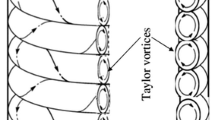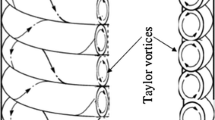Abstract
The effect of small bubbles on reduction of energy dissipation has been numerically investigated in a vertical Couette–Taylor system. Flow is in the annular space between two concentric cylinders as the internal cylinder is rotating while the outer cylinder is stationary. Main fluid between cylinders is silicone, while air bubbles are constantly injected into the main flow at the bottom of cylinders’ gap. The air bubbles rise through the flow when they are injected into the silicone flow. The flow is fully turbulence and Taylor vortices have appeared in the annulus gap. The rotational Reynolds number (Reω) varies from 700 to 3000. The fully two-phase turbulent flow has been studied using a discrete phase model and Euler–Lagrange approach. Air bubbles distribution or bubbles pattern through the main flow, which is acquired using numerical method, shows a good agreement to those acquired via experimental data in all Reynolds numbers. To investigate the changes of skin friction drag, the rate of energy dissipation in the system is calculated. The effect of injected air with constant flow rate on the total energy dissipation rate and the drag coefficient is also investigated. The results confirmed reduction of energy dissipation and about 25% of drag reduction when small bubbles were injected in the system. This reduction was the effect of the bubbles on the density of fluid and transformed momentum. Moreover, the acquired numerical results were in good agreement with those found in the previous experimental works, in which maximum Reω is up to 3000.







Similar content being viewed by others
Abbreviations
- F D :
-
Drag force
- Fr:
-
Froude number
- G :
-
Gravity (m/s2)
- I :
-
Turbulence intensity
- M :
-
Mach number
- Q :
-
Volume rate (m3/s)
- Re :
-
Reynolds number
- R :
-
Radius
- Ta:
-
Taylor number
- U :
-
The average velocity
- U :
-
Velocity(m/s)
- u′:
-
Velocity in Reynolds stress (m/s)
- νw :
-
The kinematic viscosity of the pure water
- Y :
-
Dissipation term
- We:
-
Weber number
- B :
-
Bubble
- D :
-
Drag
- K :
-
Power gain factor
- i :
-
X direction
- j :
-
Y direction
- k :
-
Z direction
- T :
-
Temperature
- α :
-
Volume fraction (closure coefficient in the dissipation rate equation)
- β*:
-
Closure coefficient in the turbulent-kenetic energy equation
- δ :
-
Radial gap
- σ :
-
Surface tension
- μ :
-
Viscosity
- μ t :
-
Turbulence viscosity
- ω :
-
Energy dissipation rate
- ρ :
-
Density (kg/m3)
- Ω :
-
Vorticity
References
McCormick ME, Bhattacharyya R (1973) Drag reduction of a submersible hull by electrolysis. Naval Eng J 85(2):11–16
Bodgevich VG, Evseev AR (1976) The distribution of skin friction in a turbulent boundary layer of water beyond the location of gas injection. Investigations of boundary layer control. Thermophysics Institute Publishing, p 62 (in Russian)
Bogdevich VG, Evseev AR, Mayyuga AG, Migirenko GS (1977) Gas-saturation effect on near-wall turbulence characteristics. In: Stephens HS, Clark JA (eds) Proc second international conference on drag reduction. Cambridge, England. BHRA Fluid Engineering pp D2–D25
Madavan NK, Deutsch S, Merkle CL (1984) Reduction of turbulent skin friction by micro bubbles. Phys Fluids 27:356–363
Madavan NK, Merkle CL, Deutsch S (1985) Numerical investigations into the mechanisms of microbubble drag reduction. J Fluids Eng 107(3):370–377
Kim SY, Cleaver JW (1995) The persistence of drag reduction following the injection of microbubbles into a turbulent boundary layer. Int Commun Heat Mass Transf 22(3):353–357
Kodama Y, Kakugawa A, Takahashi T, Kawashima H (2000) Experimental study on microbubbles and their applicability to ships for skin friction reduction. Int J Heat Fluid Flow 21(5):582–588
Deutsch S, Castano J (1986) Microbubble skin friction on an axisymmetric body. Phys Fluids 29(11):3590–3597. https://doi.org/10.1063/1.865786
Lance M, Bataille J (1991) Turbulence in the liquid phase of a uniform bubbly air–water flow 222:95–118. https://doi.org/10.1017/S0022112091001015
Deutsch S, Fontaine AA (1992) The influence of the type of gas on the reduction of skin friction drag by microbubble injection. Exp Fluids 13(2):128–136. https://doi.org/10.1007/BF00218158
Pal S (1989) Turbulence characteristics and bubble dynamics of a microbubble modified boundary layer. Ph.D. thesis the Pennsylvania State University
Kato H, Miyanaga M, Haramoto Y, Guin MM (1994) Frictional drag reduction by injecting bubbly water into turbulent boundary layer. In: Proc. 1994 cavitation and gas-liquid flow in fluid machinery and devices ASME 190, pp 185–194
Kanai A, Miyata H (2001) Direct numerical simulation of wall turbulent flows with microbubbles. Int J Numer Meth Fluids 35(5):593–615
Xu J, Maxey MR, Karniadakis GE (2002) Numerical simulation of turbulent drag reduction using micro-bubbles. J Fluid Mech 468:271–281. https://doi.org/10.1017/S0022112002001659
Kitagawa A, Sugiyama K, Ashihara M, Hishida K, Kodama Y (2003) Measurement of turbulence modification by microbubbles causing frictional drag reduction. Proc ASME 1:675–681. https://doi.org/10.1115/FEDSM2003-45648
Couette M (1890) Etudes sur le frottement des liquides. Ann Chim Phys 21:433–510
Mallock A (1896) Experiments on fluid viscosity. Philos Trans R Soc Lond Ser A 187:41–56
Taylor GI (1923) Stability of a viscous liquid contained between two rotating cylinders. Philos Trans R Soc Lond Ser A 223:289–343
Van den Berg TH, Luther S, Lathrop D, Lohse D (2005) Drag reduction in bubbly Taylor–Couette turbulence. Phys Rev Lett 94(4):044501. https://doi.org/10.1103/PhysRevLett.94.044501
Van den Berg TH, van Gils DPM, Lathrop DP, Lohse D (2007) Bubbly turbulent drag reduction is a boundary layer effect. Phys Rev Lett 98(8):08450. https://doi.org/10.1103/PhysRevLett.98.084501
Murai Y, Oiwa H, Takeda Y (2008) Frictional drag reduction in bubbly Couette-Taylor flow. Phys Fluids 20(3):034101. https://doi.org/10.1063/1.288447
Cazley C Jr (1985) Heat transfer characteristics of the rotational and axial flow between cocentric cylinders. Trans ASME 80:77–90
Lu J, Fernadez A, Tryggvason G (2005) The effect of bubbles on the wall drag in a turbulent channel flow. Phys Fluids 17(9):1–12. https://doi.org/10.1063/1.2033547
Legner HH (1984) A simple model for gas bubble drag reduction. Phys Fluids 27(12):2788–2790. https://doi.org/10.1063/1.864592
Lewis GS, Swinney HL (1999) Velocity structure functions, scaling, and transitions in high-Reynolds-number Couette–Taylor flow. Phys Rev E 59(5):5457–5467. https://doi.org/10.1103/PhysRevE.59.5457
Author information
Authors and Affiliations
Corresponding author
Additional information
Technical Editor: Jader Barbosa Jr.
Rights and permissions
About this article
Cite this article
Shafiei Mayam, M.H., Maryami, R. & Ghafurian, M.M. Investigation of the effect of small bubbles on energy dissipation in a vertical Couette–Taylor system. J Braz. Soc. Mech. Sci. Eng. 40, 244 (2018). https://doi.org/10.1007/s40430-018-1063-2
Received:
Accepted:
Published:
DOI: https://doi.org/10.1007/s40430-018-1063-2




